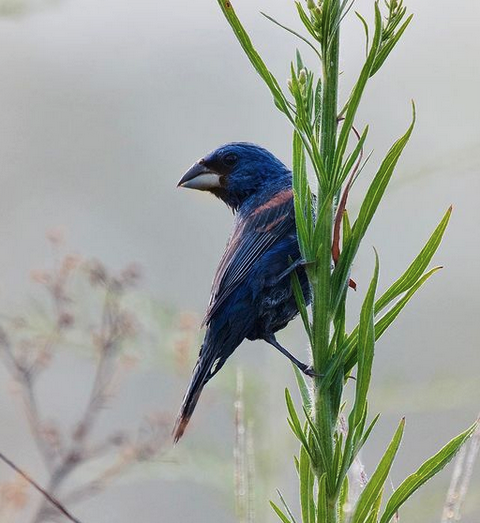One of my favorite places to visit during late summer is the Art Park at the NCMA in Raleigh North Carolina. Along with the wide array of colors in flower fields there are plenty of beautiful birds to be found here too.
Two species which are particularly common in the area are the Indigo Bunting and the Blue Grosbeak.
Even on a cloudy day, these gorgeous azure hued birds are absolutely stunning when viewing them at close range.
With similar colors and habitat preferences, Indigo Buntings & Blue Grosbeaks can be difficult to tell apart.
I’ve often been asked often what ID marks are helpful in differentiating the species so here are a couple of notes which may help you in the field.

-Indigo Bunting-(1st photo)
*Male and female Indigo Buntings lack wingbars. Adult male wings are entirely blue with black points.
*Indigo Buntings have a much smaller, narrower, pointy beak.
*The head of an Indigo Buntings is rounded, smaller and more delicate.

-Blue Grosbeak-(2nd photo)
*Male Blue Grosbeaks have two rusty colored wingbars. While not as pronounced as on the males, the tan-colored females will also show two brownish wingbars.
*Similar to Northern Cardinals, Blue Grosbeaks have a large, heavy triangular shaped bill, the top edge of which nearly forms a straight line into the forehead.
*The head of a Blue Grosbeaks is large and squared off giving them a decidedly block-headed appearance.
Bonus Tip!
Size: The average Blue Grosbeak is nearly twice the weight of an Indigo Bunting.
This is something you’ll notice if you happen to see both species in the same day.
If you’d like to test your ID skills in telling these blue beauties apart, the North Carolina Museum of Art Park is an excellent place to do this!
Photos by @sally_siko of @birdwatching_nc on the fabulous full frame SLR, the @canonusa
#5Ds
